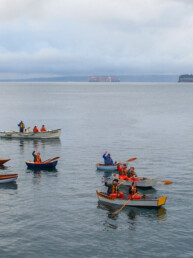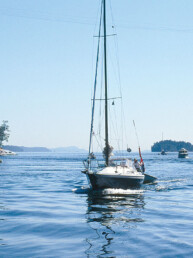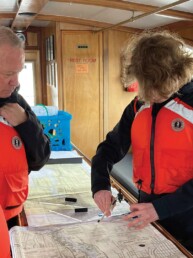Seasickness Prevention and Treatment Tips from a Doctor Who is Also an Avid Sailor
From the July, 2019 issue of 48° North.
If you happen to be one of the few lucky mariners who has weathered storms and violent sea states in vessels that are less than sea-kindly without a twinge of queasiness, you probably won’t understand the misery of the age-old nemesis of humanity at sea: seasickness. Even if you don’t suffer from seasickness, don’t just stop reading; someone you sail with probably does. For the rest of us, even if we’ve never suffered from the scourge, we probably have a visceral awareness that it’s possible under the right circumstances. We understand the reality or at least the threat embodied in the bad local pun when people refer to the Strait of Juan de Puka. And if you’ve ever been truly seasick, you will truly understand the old joke: “I was so seasick it was only the hope of dying that kept me alive.”
So, who gets seasick? Even the most seasoned salts are not really exempt, because given enough pitch, yaw, and roll, everyone gets sick. And contrary to some myths propagated mostly by those fortunate enough not to have experienced seasickness, the condition is not caused by psychological or constitutional weakness. It is merely a function of what physiologists call “sensory incongruity,” or conflicting inputs that confuse the brain. Despite recent advances in neuroscience, a clear understanding of just what happens when one gets seasick remains elusive. Nevertheless, some patterns are clear.
Children under the age of two almost never become seasick. Adults over the age of 50 demonstrate diminishing susceptibility. Unfortunately, women, despite their superior toughness in so many areas, are more susceptible, especially when pregnant, menstruating, or taking birth control pills. Then there are special groups. People with damage to their vestibular apparatus, or inner ear, which helps control balance often are less likely to develop motion sickness. People who are blind can still develop seasickness. Finally, it appears that people with classic migraine headaches are far more likely to develop seasickness, which has implications for possible new treatment approaches.
For the vast majority of us, prevention and, if need be, treatment are what we need to understand. Because the circumstances, symptoms, and severity of seasickness are so highly variable, a myriad of folk remedies, empirical treatments, and downright superstition have been invoked over the years. And while there are still any number of myths and misunderstandings that surround seasickness in our modern era, we should all be grateful that we are able to view this ancient scourge utilizing at least some of the tools of modern science. Examples of historical attempts to deal with seasickness include the following from the first millennium in China: drinking the urine of young boys, swallowing white sand-syrup, collecting water drops from a bamboo stick, or hiding earth from the kitchen hearth under the hair.
Early European approaches were no better. In the Shetland Islands, they included such recommendations as: a drink of water in which a stone found in the stomach of a cod is placed. From Iceland, it was ingesting the turf from a graveyard. In many cases, if all else failed, copious amounts of alcohol seemed to be the remedy of choice.
Today, by combining empirical observation, controlled scientific studies, increasing knowledge of pharmacology, and common sense, there is more hope for the seasickness sufferer than in past eras.
The best approach is prevention. When seasickness is the topic, the discussion immediately zeros in on specific measures and interventions that are deemed helpful. We lose sight of the big picture which includes considerations such as the planning of a voyage or maneuvers taken underway to improve the motion of a vessel. For example, sailing upwind into a wind-versus-tide situation may be asking for trouble. Or if you are on a close-hauled course and the crew is getting green, changing the point of sail can work wonders. As is always the case when cruising or voyaging, schedule flexibility can often prevent all manner of problems.
On the individual level, there are also a number of commonsense things that are helpful. Getting a good night’s sleep and avoiding alcohol prior to departure are always a good idea; as is a protein-rich meal before going on the water. Another important consideration is what can be called pre-hydration. One of the more worrisome complications of severe seasickness can be dehydration. Being hydrated prior to departure may mean an additional inconvenient trip to the head, but it provides a well hydrated starting point should vomiting develop.
Another example of folk wisdom being confirmed by science involves what is known as vestibular habituation, or in plain English, gradually increasing motion prior to setting sail. The old recommendation to sail as much as possible and sleep at anchor prior to departing on a voyage has been shown physiologically to have merit. In fact, there are now specialized therapies that employ habituation exercises that can result in significant improvement in the amount of motion that can be tolerated. This makes sense when you think about it because, after all, this is exactly what happens when the seasickness sufferer miraculously develops their “sea legs” after hours or days.
The next level of prevention kicks in while underway. There are any number of simple, time-honored things to do—and to avoid—which reduce the odds of seasickness developing. These include remaining on deck or in the cockpit, gazing at the horizon, avoiding reading or near-vision tasks such as charting, avoiding strong odors (most notoriously diesel and exhaust fumes) and if possible, taking the helm. All these interventions are simple, safe, well-known, and effective. There are also other safe and simple interventions that are less rigorously researched but that have their passionate advocates. These include acupressure wristbands and inserting an earplug in one’s non-dominant ear. No doubt you have heard other suggestions as well, some of which even make you wonder just which millennium we live in!
Other preventative measures involve pharmacology. Ginger root, raw or in a more palatable candied form, has been well researched and found to be reasonably effective. Ginger beer (non-alcoholic) can also help.
There are several over-the-counter motion sickness prevention medications that can be beneficial for many people. They are all anti-histamines. (For the sake of the following discussion, I will refer to all medications, OTC or prescription, by their chemical or generic names with US trade names in parentheses). Of these medications, meclizine (Bonine, Travel-Ease, Dramamine Less Drowsy) and dimenhydrinate (Dramamine, Driminate, in Canada: Gravol) are most readily available. Cinnarizine (Stugeron) which is not available in the US or Canada has an almost cult-like following in some sailing circles, but in clinical trials it has been shown not to be superior to other antihistamines. (Its lack of availability here could enhance its placebo effect, however!) All anti-histamines can induce drowsiness, so care needs to be exercised when you or a crew member are using them. It should be noted that non-sedating antihistamines like loratidine and cetirizine are not effective in the prevention of seasickness. The most commonly prescribed prescription preventative is scopolamine. It is found in a transdermal delivery system (Transderm Scop, and in Canada: Buscopan) that is applied behind the ear 8-12 hours prior to a voyage. It can be changed in 72 hours. Side effects include dry mouth, blurred vision, confusion and urinary retention. It should be used with caution by sailors over the age of 65 or with a history of prostate trouble. Anyone with narrow angle glaucoma should never use scopolamine.
For prevention of seasickness, these two groups of drugs have pros and cons. Scopolamine is marginally more effective but has more side-effects, some of which can be serious. It also requires a prescription and is relatively expensive. The antihistamines are easier to adjust due to more rapid onset and frequency of dosing and are readily available. Much of the choice depends on the duration of the exposure to an active seaway. On a short daysail the short-acting antihistamines make more sense.
In the event that antihistamines and scopolamine have previously proven ineffective for prevention, a prescription anti-emetic called promethazine (Phenergan) can be used. While it is less researched for prevention, it’s efficacy for treatment of seasickness is well known (see below).
Finally, for those who get migraines, preventative treatment with one of the triptan class of medications such as rizatriptan (Maxalt) which is commonly used to abort or treat a migraine, may be a possibility. Research is scant but evolving.
If efforts at prevention fail and the sailor begins vomiting, treatment strategies come into play. The severity of seasickness can vary considerably. For some people, a little chumming to Neptune occurs and that’s it. They can actually feel better afterward. For others, the vomiting becomes frequent and potential complications can develop. The most significant problem is dehydration. Many seasickness sufferers are reluctant to eat or drink between bouts of throwing up. It seems counterintuitive to do so but is important. Even sips retained for a few minutes can be absorbed. What to drink? Initially, anything that is palatable is fine, but over time, electrolyte deficiencies can develop. The best bet is to give your sick crew member sodium-rich broth like bullion, instant noodle soups and the like. “Electrolyte” drinks are often deficient in the very electrolytes they purport to replace. Alternating salty and sugary drinks is also a good way to go. What you really need is water, salt and sugar. If you are keeping an eye on a vomiting crew member, take note of when/whether they need to urinate. If after a few hours they don’t, it can be a sign that they are getting behind in fluids.
Medication is a mainstay of treating seasickness. There are several options, but the best researched and most frequently used is promethazine (Phenergan). It is available by prescription in tablet form as well as suppositories, which is an excellent way to get medication on board without having to worry about keeping pills down. Aside from the “yuck” factor, any seasick sailor can master self-administration, given a little privacy. Promethazine is the drug of choice in the US Navy, Royal Navy, and among cruise-line docs. Side effects include drowsiness, but this can, if necessary, be countered by taking pseudoephedrine (Sudafed). Another medication option is prochlorperazine (Compro, the “Compazine” trade name has been discontinued), but it is less well researched, and it is in a class of drugs called phenothiazines, which were developed as anti-psychotics and which can have rare but very troublesome side-effects. Disappointingly, drugs like ondansatron (Zofran) which are highly effective when used for post-op or illness-related nausea and vomiting, are ineffective for seasickness.
One final aspect of treating the seasick sailor segues into a closing discussion on how to integrate a sick crew member into the new reality on board. By far, the best position for an actively ill sailor is the supine position (lying down, face upwards). This is physiologically proven. Compelling a sick crew member to continue to keep watch is unhelpful and invites subsequent problems. He/she is probably apathetic from the motion sickness, sedated from the anti-emetics and for all intents and purposes, pretty much useless and in the way. The risk of an additional injury or crew overboard scenario is increased. It makes no sense to court disaster. Besides, in many cases, with active treatment utilizing anti-emetic suppositories and horizontal rest, the crewman will recover faster than soldiering on. Show some flexibility and compassion and be glad it’s not you!
It’s been said that sailing is a sport that self-selects for those who are less prone to motion sickness. It is true that someone who routinely gets seasick with very little provocation will not enjoy time under sail. But most sailors can and will get seasick under certain conditions. It is not a sign of fear or weakness. A scientific, non-judgemental approach to the malady may make our sport more accessible to many who may hesitate to become sailors for fear of becoming seasick. After all, some of the greatest mariners of all time—think Admiral Lord Nelson—were frequent sufferers. For many of us, seasickness is just the price of admission to a world of wonder and joy that keeps us coming back for more!
Post script and disclaimer: The foregoing is general medical information only. It is not specific advice for any given individual or situation. If you have any past or current medical conditions, are taking any prescription or over-the-counter medications regularly, or have any questions regarding the above information, please consult your family physician.
Ken Fabert
Ken Fabert, MD, is a recently retired primary care physician who sails the Salish Sea in his 39’ Nauticat pilothouse sloop, Vega, undeterred by his extensive personal experience with many aspects of the prevention and treatment of mal de mer. He is the physician presenter for the local US Sailing Safety at Sea seminars.






